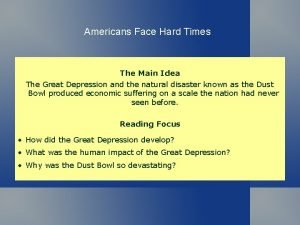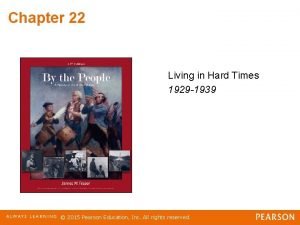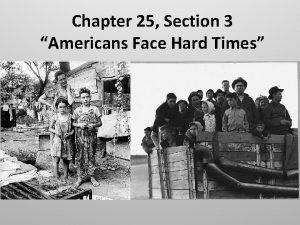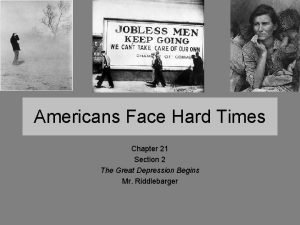Americans Face Hard Times The Main Idea The









- Slides: 9

Americans Face Hard Times The Main Idea The Great Depression and the natural disaster known as the Dust Bowl produced economic suffering on a scale the nation had never seen before. Reading Focus • How did the Great Depression develop? • What was the human impact of the Great Depression? • Why was the Dust Bowl so devastating?

Great Depression by the Numbers • After the stock market crash, economic flaws helped the nation sink into the Great Depression, the worst economic downturn in history. • The stock market collapse strained the resources of banks and many failed, thus creating greater anxiety. • In 1929 banks had little cash on hand were vulnerable to “runs, ” or a string of nervous depositors withdrawing money. • A run could quickly drain a bank of all its cash and force its closure. • In the months after October 1929, bank runs struck nationwide and hundreds of banks failed, including the enormous Bank of the United States. • Bank closures wiped out billions in savings by 1933. Today, insurance from the federal government protects most people’s deposits, and laws today require banks to keep a large percentage of their assets in cash to be paid to depositors upon request.

Farm Failures • The hard times farmers faced got worse during the Great Depression, when widespread joblessness and poverty cut down on the demand for food as many Americans simply went hungry. • By 1933, with farmers unable to sell food they produced, farm prices had sunk to 50 percent of their already low 1929 levels. • Lower prices meant lower income for farmers, and many borrowed money from banks to pay for land equipment. • As incomes dropped, farmers couldn’t pay back their loans, and in the first five years of the 1930 s, hundreds of thousands of farms went bankrupt or suffered foreclosure. Foreclosure occurs when a lender takes over ownership of a property from an owner who has failed to make loan payments.

Unemployment • The year following the crash of October 1929 saw a sharp drop in economic activity and a steep rise in unemployment. • Such negative trends are not uncommon in times of economic downturn, but the extent and duration of these trends made the Great Depression different. • By 1933 the gross national product dropped over 40 percent from its pre-crash levels. • Unemployment reached a staggering 25 percent, and among some groups the numbers were even higher: – In the African American neighborhood of Harlem, for example, unemployment reached 50 percent in 1932.

The Human Impact of the Great Depression The true measure of the Great Depression’s disaster lies in how it affected the American people. Hoovervilles • In the earliest days of the Great Depression, most families who lost jobs begged, became hobos, or went without basic necessities. • Some who lost their homes lived in closely grouped shacks, or Hoovervilles, named after President Hoover who many blamed for the Great Depression. Hoboes • Hoboes were mostly men, but included teens and women. • Hoboes were people who hopped trains to look for work • Finding food was a constant challenge, because people had little to spare and rarely shared with hoboes. • Hoboes developed a system of sign language to warn of possible dangers or opportunities.

The Emotional Impact of the Depression • The Great Depression’s worst blow might have been to the minds and spirits of the American people. • Though many shared the same fate, the unemployed often felt that they failed as people. • Many of the unemployed felt ashamed angry about receiving handouts during the Great Depression • Anger was another common emotion, because many felt the nation had failed the hardworking citizens who had helped build it.

Devastation in the Dust Bowl • Nature delivered another cruel blow. In 1931 rain stopped falling across much of the Great Plains region. • The Great Plains drought of the 1930 s help to create the Bowl • Agricultural practices in the 1930 s left the area vulnerable to droughts. • Land once covered with protective grasses was now bare, with no vegetation to hold the soil in place. • When wind storms came, they stripped the rich topsoil and blew it hundreds of miles. The dust sometimes flew as far as the Atlantic Coast. • Dust mounds choked crops and buried farm equipment, and dust blew into windows and under doors. • The Dust Bowl is the term that describes the devastation of the Great Plains by drought.

Fleeing the Plains The droughts and dust storms left many in the Dust Bowl with no way to make a living, and some simply picked up and moved: Migrants • By the end of the 1930 s, 2. 5 million people had left the Great Plains states. • Many headed along Route 66 to California, then settled in camps and sought work on farms. • The migrants were called Okies, after the state of Oklahoma, but migrants came from many states. • Many migrants met hardship and discrimination. American Imagination • The plight of the migrants captured the imagination of some of America’s greatest writers and artists. • John Steinbeck wrote the novel The Grapes of Wrath about tenant farmers during the Great Depression • The book spoke of the hardships all Americans felt during the Great Depression. For much of the decade, the Depression defied most government efforts to defeat it, and Americans had to fend for themselves.

















